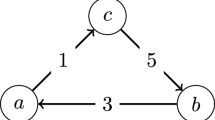Abstract
In recent years, the Pirate Party of Sweden, the Wikimedia Foundation, the Debian project, the “Software in the Public Interest” project, the Gentoo project, and many other private organizations adopted a new single-winner election method for internal elections and referendums. In this article, we will introduce this method, demonstrate that it satisfies, e.g., resolvability, Condorcet, Pareto, reversal symmetry, monotonicity, and independence of clones and present an O(C^3) algorithm to calculate the winner, where C is the number of alternatives.
Similar content being viewed by others
References
Arrow KJ, Raynaud H (1986) Social choice and multicriterion decision-making. MIT Press, Cambridge
Börgers C (2009) Mathematics of social choice: voting, compensation, and division. SIAM, Philadelphia
Camps R, Mora X, Saumell L (2008) A continuous rating method for preferential voting. Working paper
Fishburn PC (1977) Condorcet social choice functions. SIAM J Appl Math 33: 469–489
Floyd RW (1962) Algorithm 97 (Shortest Path). Commun ACM 5: 345
Kopfermann K (1991) Mathematische Aspekte der Wahlverfahren. BI-Verlag, Mannheim
Levin J, Nalebuff B (1995) An introduction to vote-counting schemes. J Econ Perspect 9: 3–26
McCaffrey JD (2008) Test run: group determination in software testing. MSDN Magazine, Redmond, Washington
Moulin H (1988) Condorcet’s principle implies the no show paradox. J Econ Theory 45: 53–64
Nurmi HJ (1987) Comparing voting systems. Springer-Verlag, Berlin
Rivest RL, Shen E (2010) An optimal single-winner preferential voting system based on game theory. Working paper
Saari DG (1994) Geometry of voting. Springer-Verlag, Berlin
Smith JH (1973) Aggregation of preferences with variable electorate. Econometrica 41: 1027–1041
Stahl S, Johnson PE (2006) Understanding modern mathematics. Jones & Bartlett Publishing, Boston
Tideman TN (1987) Independence of clones as a criterion for voting rules. Soc Choice Welf 4: 185–206
Tideman TN (2006) Collective decisions and voting: the potential for public choice. Ashgate Publishing, Burlington
Wright B (2009) Objective measures of preferential ballot voting systems. Doctoral dissertation, Duke University, Durham, North Carolina
Yue A, Liu W, Hunter A (2007) Approaches to constructing a stratified merged knowledge base. Symbolic and quantitative approaches to reasoning with uncertainty, 9th European Conference, ECSQARU 2007
Author information
Authors and Affiliations
Corresponding author
Rights and permissions
About this article
Cite this article
Schulze, M. A new monotonic, clone-independent, reversal symmetric, and condorcet-consistent single-winner election method. Soc Choice Welf 36, 267–303 (2011). https://doi.org/10.1007/s00355-010-0475-4
Received:
Accepted:
Published:
Issue Date:
DOI: https://doi.org/10.1007/s00355-010-0475-4



